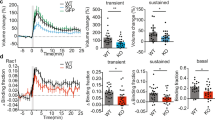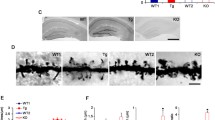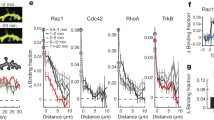Abstract
The structural plasticity of dendritic spines plays a critical role in NMDA-induced long-term potentiation (LTP) in the brain. The small GTPases RhoA and Ras are considered key regulators of spine morphology and enlargement. However, the regulatory interaction between RhoA and Ras underlying NMDA-induced spine enlargement is largely unknown. In this study, we found that Rho-kinase/ROCK, an effector of RhoA, phosphorylated SynGAP1 (a synaptic Ras-GTPase activating protein) at Ser842 and increased its interaction with 14-3-3ζ, thereby activating Ras-ERK signaling in a reconstitution system in HeLa cells. We also found that the stimulation of NMDA receptor by glycine treatment for LTP induction stimulated SynGAP1 phosphorylation, Ras-ERK activation, spine enlargement and SynGAP1 delocalization from the spines in striatal neurons, and these effects were prevented by Rho-kinase inhibition. Rho-kinase-mediated phosphorylation of SynGAP1 appeared to increase its dissociation from PSD95, a postsynaptic scaffolding protein located at postsynaptic density, by forming a complex with 14-3-3ζ. These results suggest that Rho-kinase phosphorylates SynGAP1 at Ser842, thereby activating the Ras-ERK pathway for NMDA-induced morphological changes in dendritic spines.






Similar content being viewed by others
Data Availability
The datasets generated during this study are available from the corresponding author on reasonable request.
References
Anggono V, Huganir RL (2012) Regulation of AMPA receptor trafficking and synaptic plasticity. Curr Opin Neurobiol 22:461–469
Kessels HW, Malinow R (2009) Synaptic AMPA receptor plasticity and behavior. Neuron 61:340–350
Shepherd JD, Huganir RL (2007) The cell biology of synaptic plasticity: AMPA receptor trafficking. Annu Rev Cell Dev Biol 23:613–643
Vitureira N, Goda Y (2013) Cell biology in neuroscience: the interplay between Hebbian and homeostatic synaptic plasticity. J Cell Biol 203:175–186
Zeng M, Shang Y, Araki Y, Guo T, Huganir RL, Zhang M (2016) Phase transition in postsynaptic densities underlies formation of synaptic complexes and synaptic plasticity. Cell 166:1163-1175 e1112
Lee HK, Barbarosie M, Kameyama K, Bear MF, Huganir RL (2000) Regulation of distinct AMPA receptor phosphorylation sites during bidirectional synaptic plasticity. Nature 405:955–959
Krapivinsky G, Medina I, Krapivinsky L, Gapon S, Clapham DE (2004) SynGAP-MUPP1-CaMKII synaptic complexes regulate p38 MAP kinase activity and NMDA receptor-dependent synaptic AMPA receptor potentiation. Neuron 43:563–574
Murakoshi H, Yasuda R (2012) Postsynaptic signaling during plasticity of dendritic spines. Trends Neurosci 35:135–143
Murakoshi H, Wang H, Yasuda R (2011) Local, persistent activation of Rho GTPases during plasticity of single dendritic spines. Nature 472:100–104
Kasai H, Ziv NE, Okazaki H, Yagishita S, Toyoizumi T (2021) Spine dynamics in the brain, mental disorders and artificial neural networks. Nat Rev Neurosci 22:407–422
Lisman J, Yasuda R, Raghavachari S (2012) Mechanisms of CaMKII action in long-term potentiation. Nat Rev Neurosci 13:169–182
Thomas GM, Huganir RL (2004) MAPK cascade signalling and synaptic plasticity. Nat Rev Neurosci 5:173–183
Nishioka T, Amano M, Funahashi Y, Tsuboi D, Yamahashi Y, Kaibuchi K (2019) In vivo identification of protein kinase substrates by kinase-oriented substrate screening (KIOSS). Curr Protoc Chem Biol 11:e60
Nishioka T, Nakayama M, Amano M, Kaibuchi K (2012) Proteomic screening for Rho-kinase substrates by combining kinase and phosphatase inhibitors with 14-3-3zeta affinity chromatography. Cell Struct Funct 37:39–48
Muslin AJ, Tanner JW, Allen PM, Shaw AS (1996) Interaction of 14-3-3 with signaling proteins is mediated by the recognition of phosphoserine. Cell 84:889–897
Nishioka T, Nakayama M, Amano M, Kaibuchi K (2012) Proteomic screening for Rho-kinase substrates by combining kinase and phosphatase inhibitors with 14-3-3ζ affinity chromatography. Cell Struct Funct 7:39–48
Nagai T, Nakamuta S, Kuroda K, Nakauchi S, Nishioka T, Takano T, Zhang X, Tsuboi D, Funahashi Y, Nakano T, Yoshimoto J, Kobayashi K, Uchigashima M, Watanabe M, Miura M, Nishi A, Kobayashi K, Yamada K, Amano M, Kaibuchi K (2016) Phosphoproteomics of the dopamine pathway enables discovery of Rap1 activation as a reward signal in vivo. Neuron 89:550–565
Nagai T, Yoshimoto J, Kannon T, Kuroda K, Kaibuchi K (2016) Phosphorylation signals in striatal medium spiny neurons. Trends Pharmacol Sci 37:858–871
Ahammad RU, Nishioka T, Yoshimoto J, Kannon T, Amano M, Funahashi Y, Tsuboi D, Faruk MO, Yamahashi Y, Yamada K, Nagai T, Kaibuchi K (2021) Kanphos: a database of kinase-associated neural protein phosphorylation in the brain. Cells 11(1):47
Chen HJ, Rojas-Soto M, Oguni A, Kennedy MB (1998) A synaptic Ras-GTPase activating protein (p135 SynGAP) inhibited by CaM kinase II. Neuron 20:895–904
Kim JH, Liao D, Lau LF, Huganir RL (1998) SynGAP: a synaptic RasGAP that associates with the PSD-95/SAP90 protein family. Neuron 20:683–691
Bos JL, Rehmann H, Wittinghofer A (2007) GEFs and GAPs: critical elements in the control of small G proteins. Cell 129:865–877
Jeyabalan N, Clement JP (2016) SYNGAP1: Mind the Gap. Front Cell Neurosci 10:32
Llamosas N, Arora V, Vij R, Kilinc M, Bijoch L, Rojas C, Reich A, Sridharan B, Willems E, Piper DR, Scampavia L, Spicer TP, Miller CA, Holder JL, Rumbaugh G (2020) SYNGAP1 controls the maturation of dendrites, synaptic function, and network activity in developing human neurons. J Neurosci 40:7980–7994
Noboru H, Komiyama AMW, Carlisle Holly J, Porter Karen, Charlesworth Paul, Jennifer Monti DJCS, O’Carroll Colin M, Martin Stephen J, Morris Richard G. M, O’Dell Thomas J, Grant Seth G. N (2002) SynGAP regulates ERK:MAPK signaling, synaptic plasticity, and learning in the complex with postsynaptic density 95 and NMDA receptor. J Neurosci 22(22):9721–9732
Araki Y, Zeng M, Zhang M, Huganir RL (2015) Rapid dispersion of SynGAP from synaptic spines triggers AMPA receptor insertion and spine enlargement during LTP. Neuron 85:173–189
Ikeda M, Hikita T, Taya S, Uraguchi-Asaki J, Toyo-oka K, Wynshaw-Boris A, Ujike H, Inada T, Takao K, Miyakawa T, Ozaki N, Kaibuchi K, Iwata N (2008) Identification of YWHAE, a gene encoding 14-3-3epsilon, as a possible susceptibility gene for schizophrenia. Hum Mol Genet 17:3212–3222
Navarrete M, Zhou Y (2022) The 14-3-3 protein family and Schizophrenia. Front Mol Neurosci 15:857495
Cornell B, Toyo-Oka K (2017) 14-3-3 proteins in brain development: neurogenesis, neuronal migration and neuromorphogenesis. Front Mol Neurosci 10:318
Cheah PS, Ramshaw HS, Thomas PQ, Toyo-Oka K, Xu X, Martin S, Coyle P, Guthridge MA, Stomski F, van den Buuse M, Wynshaw-Boris A, Lopez AF, Schwarz QP (2012) Neurodevelopmental and neuropsychiatric behaviour defects arise from 14-3-3zeta deficiency. Mol Psychiatry 17:451–466
Xu X, Jaehne EJ, Greenberg Z, McCarthy P, Saleh E, Parish CL, Camera D, Heng J, Haas M, Baune BT, Ratnayake U, van den Buuse M, Lopez AF, Ramshaw HS, Schwarz Q (2015) 14-3-3zeta deficient mice in the BALB/c background display behavioural and anatomical defects associated with neurodevelopmental disorders. Sci Rep 5:12434
Angrand PO, Segura I, Volkel P, Ghidelli S, Terry R, Brajenovic M, Vintersten K, Klein R, Superti-Furga G, Drewes G, Kuster B, Bouwmeester T, Acker-Palmer A (2006) Transgenic mouse proteomics identifies new 14-3-3-associated proteins involved in cytoskeletal rearrangements and cell signaling. Mol Cell Proteomics 5:2211–2227
Amano M, Tsumura Y, Taki K, Harada H, Mori K, Nishioka T, Kato K, Suzuki T, Nishioka Y, Iwamatsu A, Kaibuchi K (2010) A proteomic approach for comprehensively screening substrates of protein kinases such as Rho-kinase. PLoS One 5:e8704
Medina AE, Liao DS, Mower AF, Ramoa AS (2001) Do NMDA receptor kinetics regulate the end of critical periods of plasticity. Cell Press 32:553–556
Hui-Chen Lu, Gonzalez Ernesto, Crair MC (2001) Barrel cortex critical period plasticity is independent of changes in NMDA receptor subunit composition. Cell Press 32:619–634
Molnar E (2011) Long-term potentiation in cultured hippocampal neurons. Semin Cell Dev Biol 22:506–513
Paul A, Nawalpuri B, Shah D, Sateesh S, Muddashetty RS, Clement JP (2019) Differential regulation of syngap1 translation by FMRP modulates eEF2 mediated response on NMDAR activity. Front Mol Neurosci 12:97
Feng W, Zhang M (2009) Organization and dynamics of PDZ-domain-related supramodules in the postsynaptic density. Nat Rev Neurosci 10:87–99
Kim E, Sheng M (2004) PDZ domain proteins of synapses. Nat Rev Neurosci 5:771–781
Walkup WG, Washburn L, Sweredoski MJ, Carlisle HJ, Graham RL, Hess S, Kennedy MB (2015) Phosphorylation of synaptic GTPase-activating protein (synGAP) by Ca2+/calmodulin-dependent protein kinase II (CaMKII) and cyclin-dependent kinase 5 (CDK5) alters the ratio of its GAP activity toward Ras and Rap GTPases. J Biol Chem 290:4908–4927
Lee KJ, Lee Y, Rozeboom A, Lee JY, Udagawa N, Hoe HS, Pak DT (2011) Requirement for Plk2 in orchestrated ras and rap signaling, homeostatic structural plasticity, and memory. Neuron 69:957–973
Nishimura T, Yamaguchi T, Kato K, Yoshizawa M, Nabeshima Y, Ohno S, Hoshino M, Kaibuchi K (2005) PAR-6-PAR-3 mediates Cdc42-induced Rac activation through the Rac GEFs STEF/Tiam1. Nat Cell Biol 7:270–277
Mizushima S, Nagata S (1990) pEF-BOS, a powerful mammalian expression vector. Nucleic Acids Res 18:5322
Amano M, Hamaguchi T, Shohag MH, Kozawa K, Kato K, Zhang X, Yura Y, Matsuura Y, Kataoka C, Nishioka T, Kaibuchi K (2015) Kinase-interacting substrate screening is a novel method to identify kinase substrates. J Cell Biol 209:895–912
Amano M, Chihara K, Nakamura N, Fukata Y, Yano T, Shibata M, Ikebe M, Kaibuchi K (1998) Myosin II activation promotes neurite retraction during the action of Rho and Rho-kinase. Genes Cells 3:177–188
Funahashi Y, Ariza A, Emi R, Xu Y, Shan W, Suzuki K, Kozawa S, Ahammad RU, Wu M, Takano T, Yura Y, Kuroda K, Nagai T, Amano M, Yamada K, Kaibuchi K (2019) Phosphorylation of Npas4 by MAPK regulates reward-related gene expression and Behaviors. Cell Rep 29:3235-3252 e3239
Takano T, Wu M, Nakamuta S, Naoki H, Ishizawa N, Namba T, Watanabe T, Xu C, Hamaguchi T, Yura Y, Amano M, Hahn KM, Kaibuchi K (2017) Discovery of long-range inhibitory signaling to ensure single axon formation. Nat Commun 8:33
Acknowledgements
We are grateful to T. Watanabe, T. Nishioka, K. Kuroda, S. Kozawa and other Kaibuchi laboratory members for helpful discussions and preparation of some materials, T. Ishii for secretarial assistance, and S. Furuta for life support. We also thank the Division for Research on Laboratory Animals, the Radioisotope Center Medical Branch and Medical Research Engineering of Nagoya University Graduate School of Medicine and the Education and Research Center of Animal Models for Human Diseases in Fujita Health University.
Funding
This work was supported by the following funding sources: ‘‘Bioinformatics for Brain Sciences’’ performed under the SRPBS from MEXT and AMED (KK); AMED Grant Nos. JP21dm0207075 (KK), JP21wm0425017 (YF); JSPS KAKENHI Grant Nos. JP17H01380 (KK), JP17J09461 (MW), JP17K07383 (MA), JP18K14849 (YF), JP21K06428 (YF), JP21K06427 (DT); MEXT KAKENHI Grant Nos. JP19H05209 (KK), JP21H00196 (KK); the Uehara Science Foundation (KK, YF), the Takeda Science Foundation (KK, YF), and the Hori Sciences & Arts Foundation (KK, YF).
Author information
Authors and Affiliations
Contributions
Conceptualization: [MW, YF, TT, KK]; Methodology: [MW, YF, DT, MA]; Formal analysis and investigation: [MW, YF, EH, RUA, MA]; Writing—original draft preparation: [MW]; Writing—review and editing: [YF, KK]; Funding acquisition: [MW, YF, DT, MA, KK]; Resources: [YF, TT, DT, MA]; Supervision: [KY, KK]. All authors provided critical feedback and helped shape the research, analysis, and manuscript. All authors approved the final version submitted.
Corresponding author
Ethics declarations
Conflict of interest
The authors have no relevant financial or non-financial interest to disclose.
Ethical Approval
All animal experiments were approved and performed in accordance with the guidelines for the care and use of laboratory animals established by the Animal Experiments Committee of Nagoya University Graduate School of Medicine (Approval Number: 20094) and Fujita Health University (Approval Number: AP20037). All experiments were conducted in compliance with the ARRIVE guidelines.
Consent to Participate
Not applicable.
Additional information
Publisher's Note
Springer Nature remains neutral with regard to jurisdictional claims in published maps and institutional affiliations.
Supplementary Information
Below is the link to the electronic supplementary material.
11064_2022_3623_MOESM1_ESM.eps
Supplementary file1 (EPS 1653 kb)—Interaction of SynGAP1 with 14-3-3 proteins. Extracts of mouse striatum were incubated with rabbit IgG or anti-SynGAP1 antibody for 1 hour, and then with Protein A sepharose 4 Fast Flow beads for 1 hour. The immunoprecipitates were analyzed by immunoblotting with anti-SynGAP1, anti-14-3-3 (pan), anti-14-3-3β, anti-14-3-3γ, anti-14-3-3ε, 14-3-3η, 14-3-3σ, anti-14-3-3θ, and anti-14-3-3ζ, antibodies. Data represent the mean ± SEM of three independent experiments and were analyzed by Student's t-test. *P < 0.05, **P < 0.01, ns: not significant.
11064_2022_3623_MOESM2_ESM.eps
Supplementary file2 (EPS 1912 kb)—The effect of CaMKII on the interaction of SynGAP1 with PSD95. COS7 cell lysates expressing the indicated proteins were incubated with glutathione sepharose 4B beads. The bound proteins and cell lysates were subjected to immunoblot analysis using an anti-Myc, anti-GST, anti-GFP antibodies. The data represent the mean±SEM of three independent experiments and were analyzed by one-way ANOVA with Tukey's post hoc test. **p<0.01, ***p<0.001, ****p<0.0001.
Rights and permissions
About this article
Cite this article
Wu, M., Funahashi, Y., Takano, T. et al. Rho–Rho-Kinase Regulates Ras-ERK Signaling Through SynGAP1 for Dendritic Spine Morphology. Neurochem Res 47, 2757–2772 (2022). https://doi.org/10.1007/s11064-022-03623-y
Received:
Revised:
Accepted:
Published:
Issue Date:
DOI: https://doi.org/10.1007/s11064-022-03623-y




